
Make a list of the most remote, isolated and fascinating places on the planet that you'd ever want to visit. If the Galápagos Islands are not on that list STOP READING NOW.
If you are, like me, weary of trademark tropical resorts and crave adventurous locations away from the maddening, beer-swilling crowds, then set a course for the Galápagos.
I'll wager there's a little bit of the David Attenborough in all of us and these craggy, volcanic isles 1000 kilometres off the Ecuadorian coast conjure up precisely the right sort of imagery; namely the adventure-hungry wayfarer exploring the limits of the known world. That said, I have some confessions to make; I don't want to sleep in a damp cave, eat worms or go much more than a day without a hot shower. That's why the Galápagos is my sort of place!
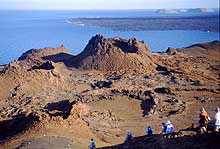 Straddling
the equator at 900 W, the Galápagos remained blissfully undiscovered
until 1535 when the becalmed Bishop of Panama, Tomás de Berlanga,
drifted 800 kilometres off course whilst travelling to Peru. Completely
unimpressed by the apparent desolation of the islands, he wrote "…
the earth is much like dross, worthless…". However, the good
bishop was credited with naming the islands after the huge saddle-like
tortoises living there.
Straddling
the equator at 900 W, the Galápagos remained blissfully undiscovered
until 1535 when the becalmed Bishop of Panama, Tomás de Berlanga,
drifted 800 kilometres off course whilst travelling to Peru. Completely
unimpressed by the apparent desolation of the islands, he wrote "…
the earth is much like dross, worthless…". However, the good
bishop was credited with naming the islands after the huge saddle-like
tortoises living there.
Decades later, man would come again, this time leaving an enduring and ugly legacy. Pirates and buccaneers used the sheltered coves to hide after raiding Spanish shipping and carelessly introduced rats, cats, dogs and goats to the islands. After these rascals departed, along came ravenous whalers and sealers who, in typical fashion, plundered the living resources to near extinction. The hapless tortoises were mercilessly decimated for their "sweet meate" and were bundled by the score into the holds of the ships.
Perhaps the most famous of all western interlopers was Charles Darwin who spent five weeks amongst the islands in 1835. Darwin was the first to properly recognise the unique qualities of the Galápagos and documented the many endemic species in great detail. In fact, it was his stay on the Galápagos that inspired the controversial "Origin of the Species".
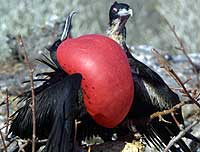 Today,
a landing on the UNESCO
World Heritage listed Galápagos Islands is a very different affair,
even though the islands themselves, particularly the more remote uninhabited
ones, remain largely unchanged. All visitors are now accompanied by
accredited naturalist guides who also closely monitor the impact of
tourists.
Today,
a landing on the UNESCO
World Heritage listed Galápagos Islands is a very different affair,
even though the islands themselves, particularly the more remote uninhabited
ones, remain largely unchanged. All visitors are now accompanied by
accredited naturalist guides who also closely monitor the impact of
tourists.
My personal experience is delightfully fresh in my mind and I often catch myself day-dreaming of wandering amongst the noisy boobies nesting in the long solidified lava flows and facing-off a disdainful iguana along the craggy shoreline. And afterwards, back on the boat, sitting down with a crisp Pilsener as the sun sets behind the still wheeling flocks of frigatebirds and brown pelicans.
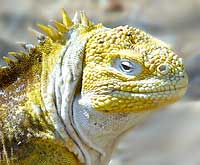 The
Galápagos Islands deliver a travel experience like nothing else. The
wildlife, tame and unruffled by your presence, confronts you as soon
as you set foot ashore. Tiny mockingbirds, brazen and cheeky, will sit
on your arm in the hope you will share your bottled water. Salacious
male boobies patrol the nesting grounds in search of corruptible females
while the unmistakable frigatebirds engage in an unashamedly exhibitionist
mating ritual.
The
Galápagos Islands deliver a travel experience like nothing else. The
wildlife, tame and unruffled by your presence, confronts you as soon
as you set foot ashore. Tiny mockingbirds, brazen and cheeky, will sit
on your arm in the hope you will share your bottled water. Salacious
male boobies patrol the nesting grounds in search of corruptible females
while the unmistakable frigatebirds engage in an unashamedly exhibitionist
mating ritual.
Grab a snorkel and a set of flippers and the beauty of the submarine world will be revealed to you. My brag list expanded considerably while paddling almost aimlessly through the shoals of brilliant blue triggerfish and neon-lit rainbow parrotfish. At one point my trance-like state was rudely disturbed when a group of three white-tipped reef sharks burst into life below me and made a beeline for the shelter of a nearby outcrop. Thankfully these altogether perfect creatures are timid and shy when it comes to snorkelers. And the waterborne activities often get interactive when playful seal pups swim over for a game of "chasey". Turtles, graceful and serene, glide effortlessly through the crystal clear water while card-table sized marbled stingrays waft magically along the undulating sea floor.
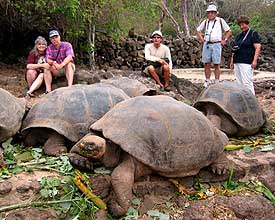 Of
course, no journey to the Galápagos would be complete without an "up-close-and-personal"
with the gentle giants of the islands - the Giant Tortoises. Even though
this threatened species can still be seen "in the wild", the
best place to observe the huge reptiles is at the Charles Darwin Research
Station on the central island of Santa Cruz. Established in 1959, along
with the proclamation of the islands as a national park, the CDRS operates
a very successful captive breeding program for the 11 sub-species of
giant tortoise. Although the days of riding bareback are over, you are
encouraged to enter the enclosures for a truly intimateexperience -
and some of these guys are REALLY big! The largest males here are well
into triple figures - both in age and weight! In fact a giant tortoise
can easily live twice as long as a human.
Of
course, no journey to the Galápagos would be complete without an "up-close-and-personal"
with the gentle giants of the islands - the Giant Tortoises. Even though
this threatened species can still be seen "in the wild", the
best place to observe the huge reptiles is at the Charles Darwin Research
Station on the central island of Santa Cruz. Established in 1959, along
with the proclamation of the islands as a national park, the CDRS operates
a very successful captive breeding program for the 11 sub-species of
giant tortoise. Although the days of riding bareback are over, you are
encouraged to enter the enclosures for a truly intimateexperience -
and some of these guys are REALLY big! The largest males here are well
into triple figures - both in age and weight! In fact a giant tortoise
can easily live twice as long as a human.
Even with so many adventure travel possibilities available today, a cruise in the Galápagos will leave a permanent, life-long effect on any visitor. No zoo or theme park can possibly hope to deliver such a genuinely enlightening and rewarding adventure.
Web Links:


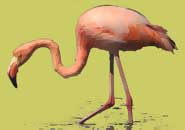 More
travel stories
More
travel stories